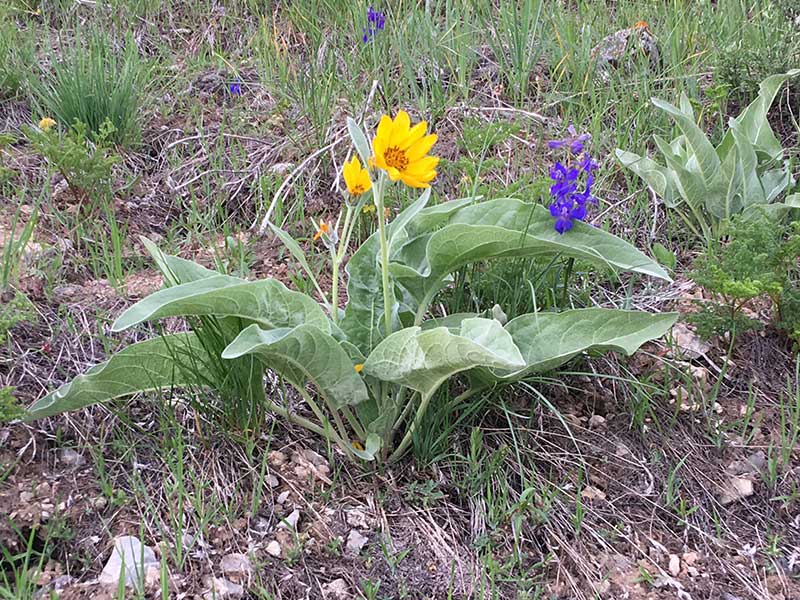Balsamorhiza sagittata / arrowleaf balsamroot
- large, bright yellow, sunflower-like blossoms in early spring
- very large, more or less triangular basal leaves
- leaves appear silvery, or grey-green due to leaf hairs
- on open, fairly dry hillsides and ridges, often with sagebrush
Also known as: Oregon sunflower, breadroot, graydock, spring sunflower
See also: Wyethia amplexicaulis / mules ear
This excessively named plant is a taprooted perennial herb with very large, generally triangular basal leaves. It has a hairy stem, perhaps 2 feet tall; upper leaves are narrowly oval and smaller than the basal ones. The leaves have untoothed edges and are coated in fine to rough hairs making them appear silvery white or greyish-green.
Arrowleaf balsamroot blooms early in the spring. As a member of the aster family, the bright yellow “flowers” are actually composite inflorescences with disk florets in the center and ray florets on the periphery. According to the writeup as the USFS plant of the week…”the inflorescence is bigger than a silver dollar but smaller than a CD; about the size of a small floppy disk”. In case you are under 40 years old, a silver dollar is 1.5″ in diameter, a CD is 4.7″ in diameter, and a 1.44 megabyte floppy is 3.5″ in diameter. You can actually still get all of those things even if you might not be able to get a floppy disk drive.
Experience in 2019 indicates that the flowering plants don’t like being snowed on or subjected to 20˚ temperatures.
The shape of the leaves explains the “arrowleaf” moniker. A large, deep, thick taproot completes the name, having a diameter the width of a hand and a branching root going as much as 9 feet deep. The thicker portions are covered with bark. The balsam portion of the name refers to a resin in the root. Balsamroot leaves arise directly from that thick woody root. In the spring, the above-ground plant regrows from the root but it is not clonal. Instead, spreading/dispersion is by seed.
Normally, this balsamroot is found on open, fairly dry hillsides and ridges, often with sagebrush. They turn their spaces a golden-yellow starting in late May (in the Valley). By the end of summer, the plants look pretty awful, all dried and shriveled up. Stands of the plant are noisy to walk through then.
Because of its showy flowers and dominance on the landscape, arrowleaf balsamroot is commonly used in restoration seedings. The species may have potential for use in oil shale, roadside and mining restoration practices, elsewhere. But seedlings grow slowly and need 3-8 years to become established.
All of the plant is edible, especially the roots… boiled, they have a taste that is piney and bitter. Yum. The seeds are also a good source of nutriment and oil. Young tissues of arrowleaf balsamroot contain nearly 30% protein. But as always, check with your mother before putting things in your mouth.
Arrowleaf Balsamroot might be confused with the equally showy mules ear (Wyethia amplexicaulis), but the two are easily distinguished by their leaves: mules ear leaves are two-to-four inches wide, quite long, and shaped like, well, a mule’s ears. Mules ear flowers are also a bit larger than arrowleaf’s, and arrowleaf begins blooming several weeks earlier.
| Color | |
|---|---|
| Family | |
| Blossom size | |
| Inflorescence size | |
| Inflorescence type | |
| When? | |
| Where? |



